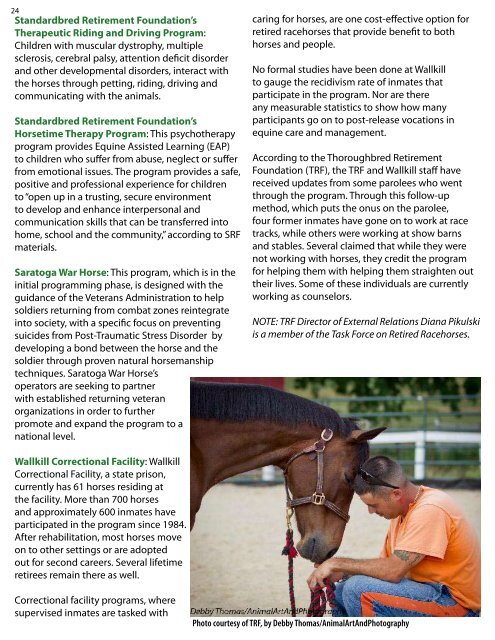Retired Racehorses
tfrr_reportandappendicesfinal
tfrr_reportandappendicesfinal
- No tags were found...
You also want an ePaper? Increase the reach of your titles
YUMPU automatically turns print PDFs into web optimized ePapers that Google loves.
24<br />
Standardbred Retirement Foundation’s<br />
Therapeutic Riding and Driving Program:<br />
Children with muscular dystrophy, multiple<br />
sclerosis, cerebral palsy, attention deficit disorder<br />
and other developmental disorders, interact with<br />
the horses through petting, riding, driving and<br />
communicating with the animals.<br />
Standardbred Retirement Foundation’s<br />
Horsetime Therapy Program: This psychotherapy<br />
program provides Equine Assisted Learning (EAP)<br />
to children who suffer from abuse, neglect or suffer<br />
from emotional issues. The program provides a safe,<br />
positive and professional experience for children<br />
to “open up in a trusting, secure environment<br />
to develop and enhance interpersonal and<br />
communication skills that can be transferred into<br />
home, school and the community,” according to SRF<br />
materials.<br />
Saratoga War Horse: This program, which is in the<br />
initial programming phase, is designed with the<br />
guidance of the Veterans Administration to help<br />
soldiers returning from combat zones reintegrate<br />
into society, with a specific focus on preventing<br />
suicides from Post-Traumatic Stress Disorder by<br />
developing a bond between the horse and the<br />
soldier through proven natural horsemanship<br />
techniques. Saratoga War Horse’s<br />
operators are seeking to partner<br />
with established returning veteran<br />
organizations in order to further<br />
promote and expand the program to a<br />
national level.<br />
caring for horses, are one cost-effective option for<br />
retired racehorses that provide benefit to both<br />
horses and people.<br />
No formal studies have been done at Wallkill<br />
to gauge the recidivism rate of inmates that<br />
participate in the program. Nor are there<br />
any measurable statistics to show how many<br />
participants go on to post-release vocations in<br />
equine care and management.<br />
According to the Thoroughbred Retirement<br />
Foundation (TRF), the TRF and Wallkill staff have<br />
received updates from some parolees who went<br />
through the program. Through this follow-up<br />
method, which puts the onus on the parolee,<br />
four former inmates have gone on to work at race<br />
tracks, while others were working at show barns<br />
and stables. Several claimed that while they were<br />
not working with horses, they credit the program<br />
for helping them with helping them straighten out<br />
their lives. Some of these individuals are currently<br />
working as counselors.<br />
NOTE: TRF Director of External Relations Diana Pikulski<br />
is a member of the Task Force on <strong>Retired</strong> <strong>Racehorses</strong>.<br />
Wallkill Correctional Facility: Wallkill<br />
Correctional Facility, a state prison,<br />
currently has 61 horses residing at<br />
the facility. More than 700 horses<br />
and approximately 600 inmates have<br />
participated in the program since 1984.<br />
After rehabilitation, most horses move<br />
on to other settings or are adopted<br />
out for second careers. Several lifetime<br />
retirees remain there as well.<br />
Correctional facility programs, where<br />
supervised inmates are tasked with<br />
Photo courtesy of TRF, by Debby Thomas/AnimalArtAndPhotography


